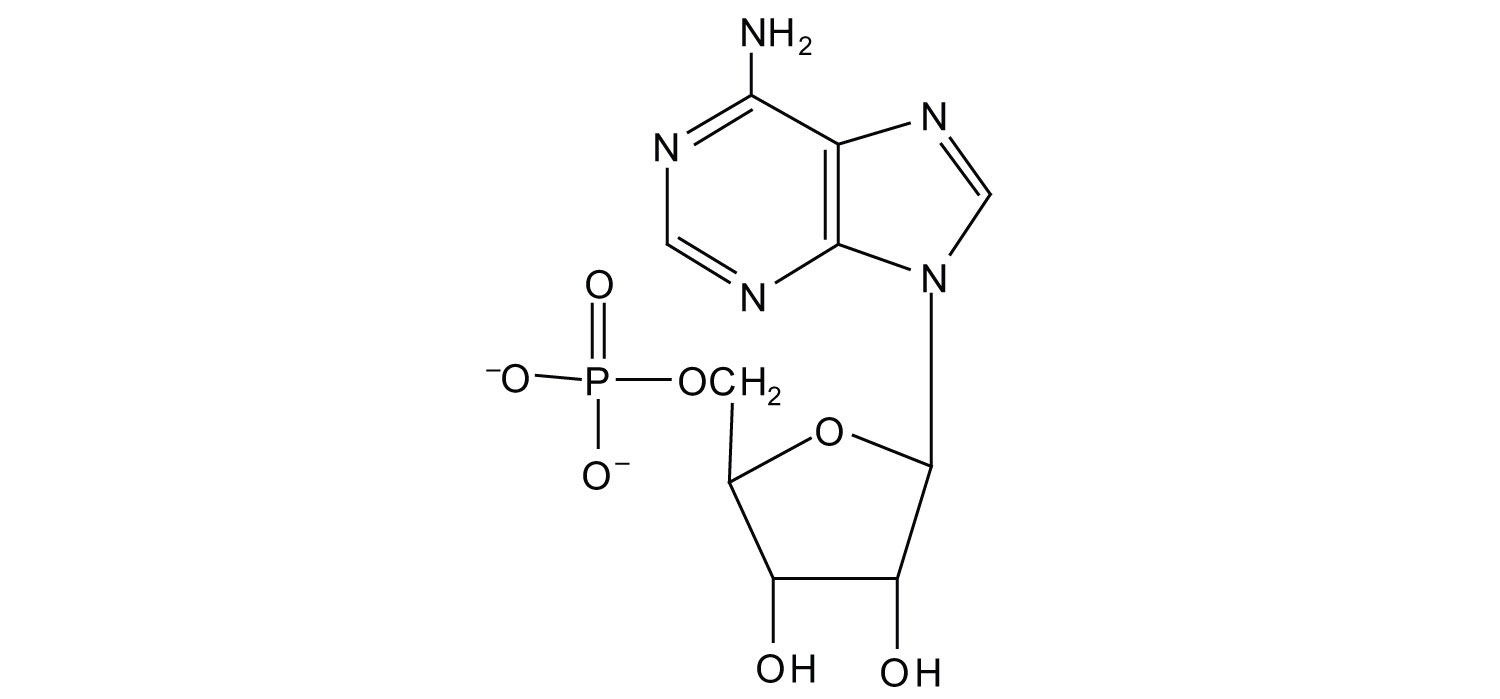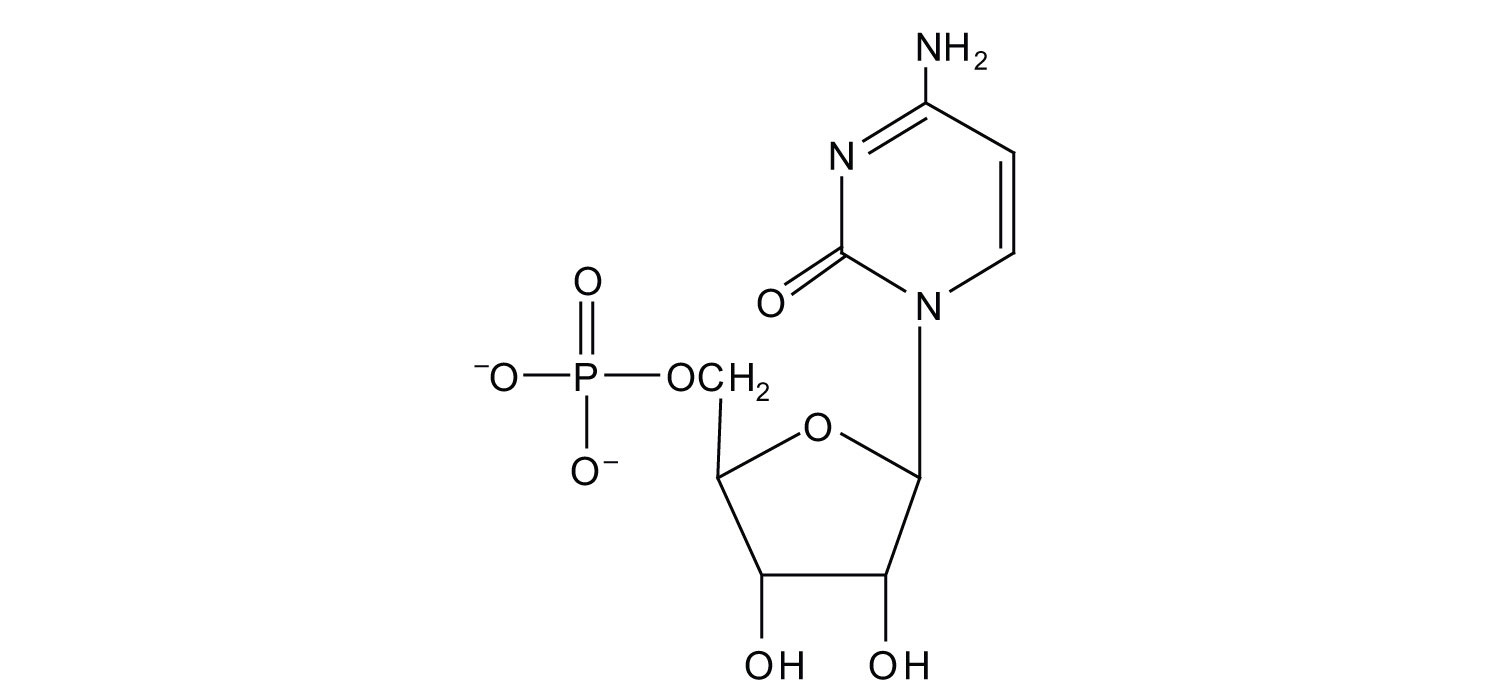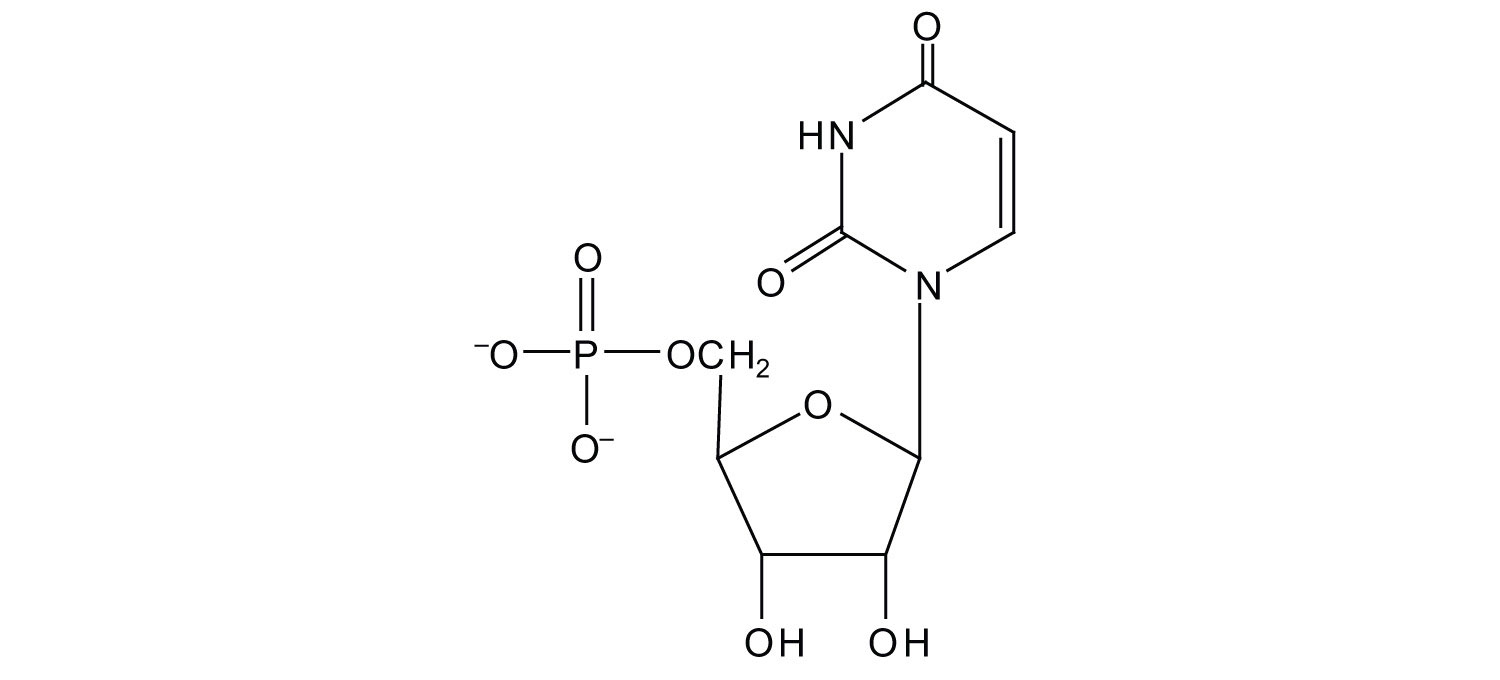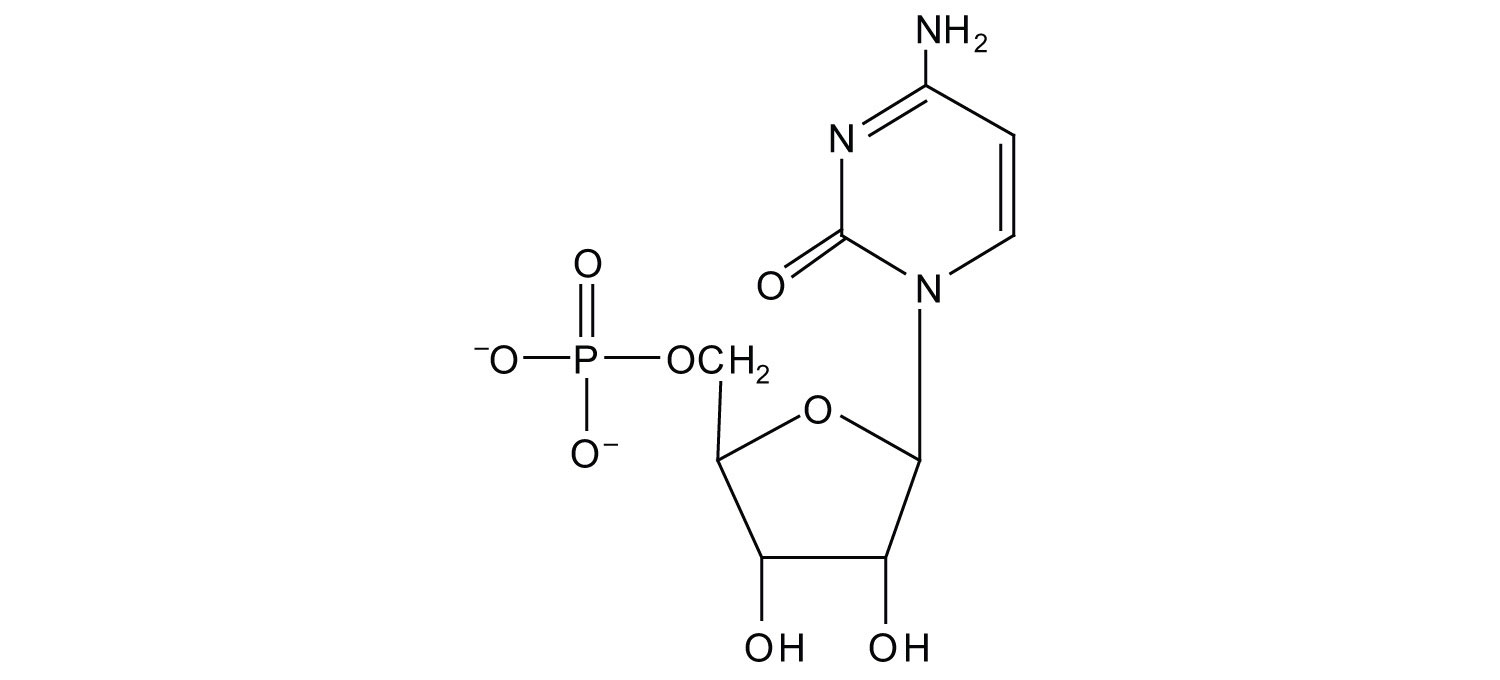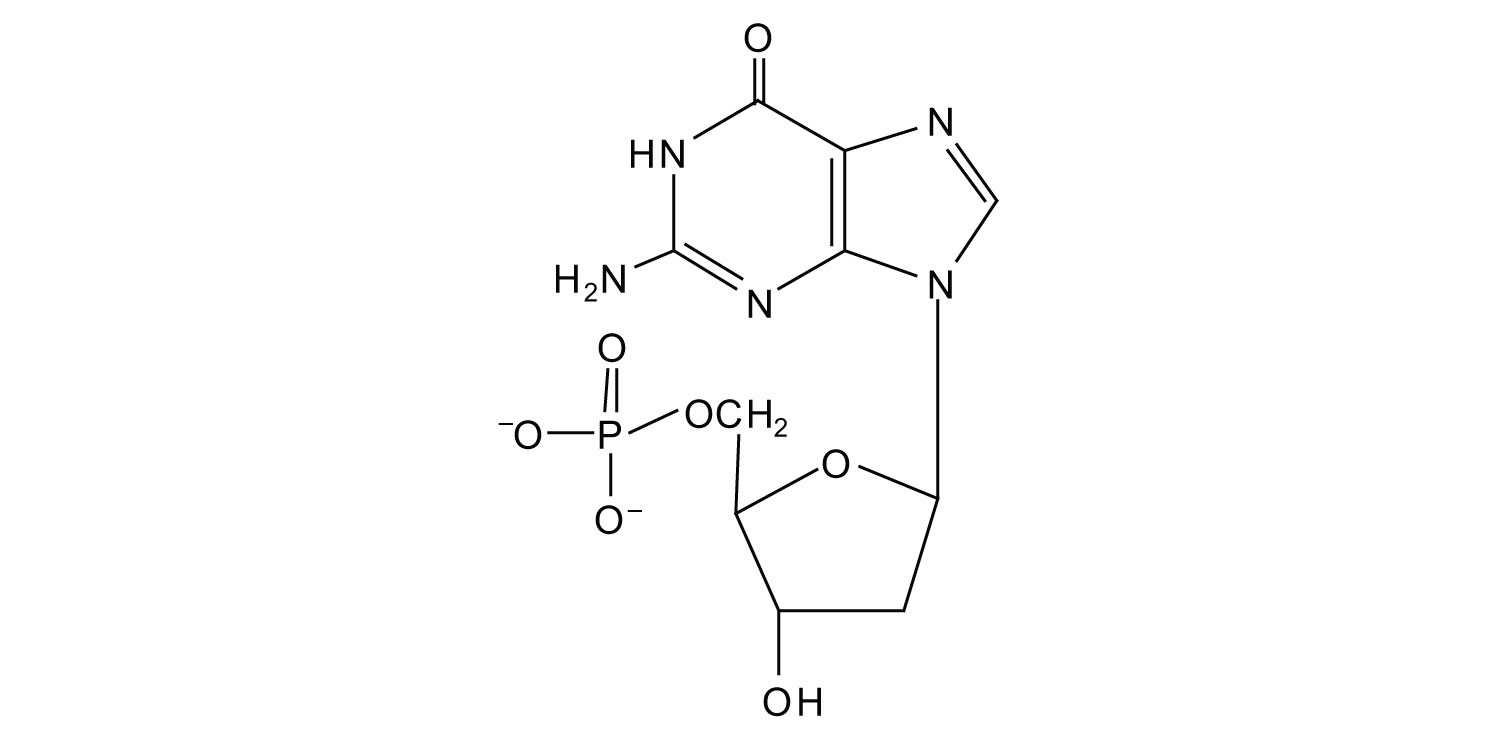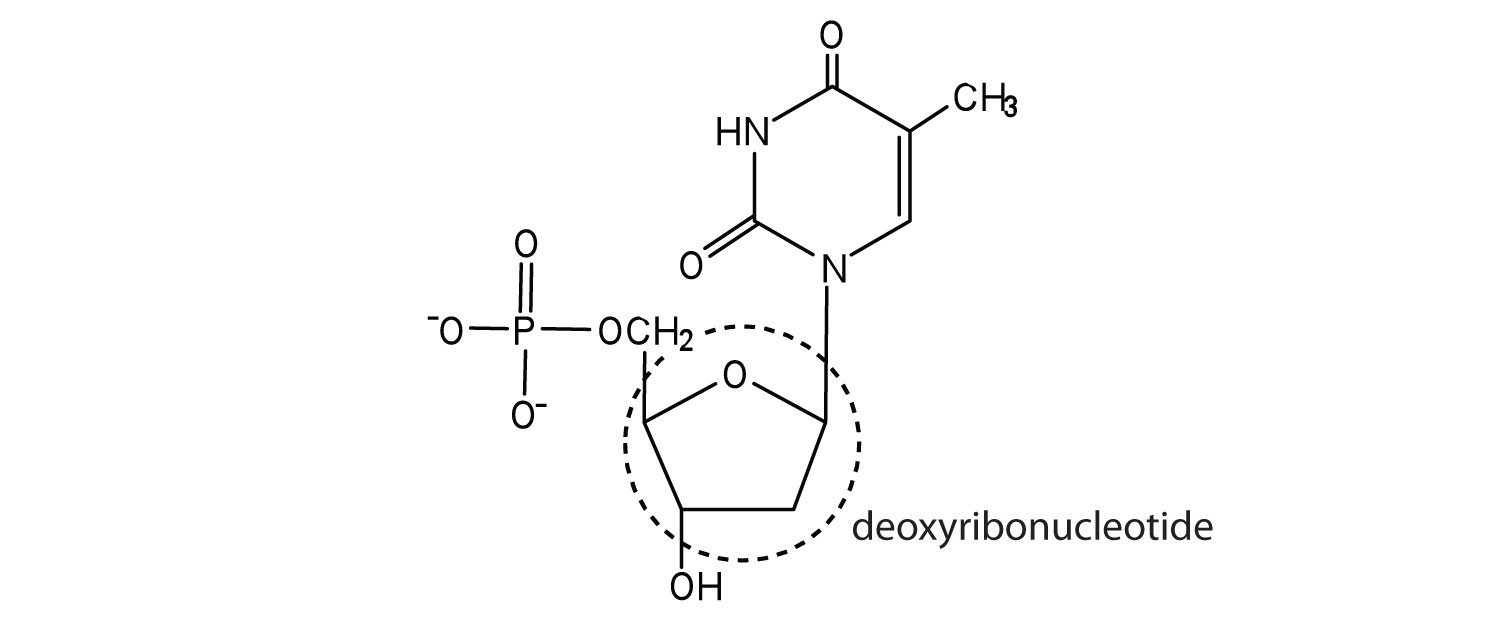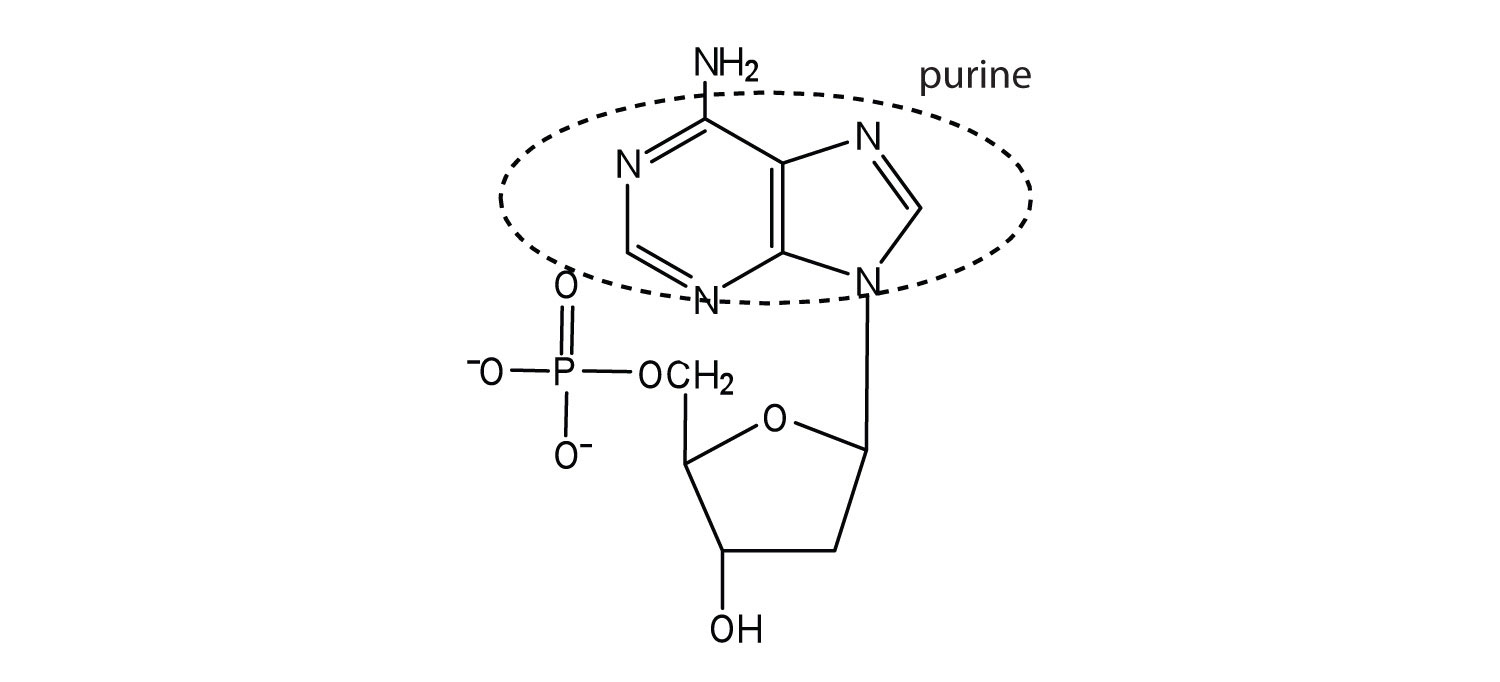This is “Nucleotides”, section 19.1 from the book Introduction to Chemistry: General, Organic, and Biological (v. 1.0). For details on it (including licensing), click here.
For more information on the source of this book, or why it is available for free, please see the project's home page. You can browse or download additional books there. To download a .zip file containing this book to use offline, simply click here.
19.1 Nucleotides
Learning Objective
- Identify the different molecules that combine to form nucleotides.
The repeating, or monomer, units that are linked together to form nucleic acids are known as nucleotidesA monomer unit that is linked together to form nucleic acids.. The deoxyribonucleic acid (DNA) of a typical mammalian cell contains about 3 × 109 nucleotides. Nucleotides can be further broken down to phosphoric acid (H3PO4), a pentose sugar (a sugar with five carbon atoms), and a nitrogenous base (a base containing nitrogen atoms).
If the pentose sugar is ribose, the nucleotide is more specifically referred to as a ribonucleotide, and the resulting nucleic acid is ribonucleic acid (RNA). If the sugar is 2-deoxyribose, the nucleotide is a deoxyribonucleotide, and the nucleic acid is DNA.
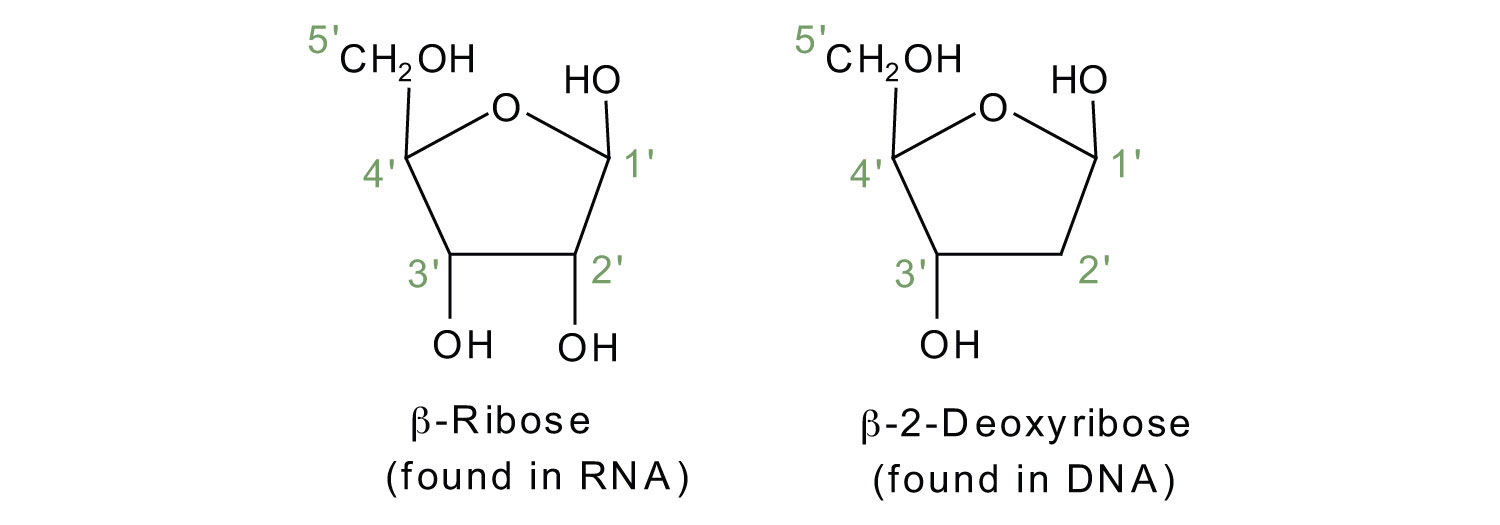
The nitrogenous bases found in nucleotides are classified as pyrimidinesA heterocyclic amine with two nitrogen atoms in a six-member ring. or purinesA heterocyclic amine consisting of a pyrimidine ring fused to a five-member ring with two nitrogen atoms.. Pyrimidines are heterocyclic amines with two nitrogen atoms in a six-member ring and include uracil, thymine, and cytosine. (For more information about heterocyclic amines, see Chapter 15 "Organic Acids and Bases and Some of Their Derivatives", Section 15.13 "Amines as Bases".) Purines are heterocyclic amines consisting of a pyrimidine ring fused to a five-member ring with two nitrogen atoms. Adenine and guanine are the major purines found in nucleic acids (Figure 19.2 "The Nitrogenous Bases Found in DNA and RNA").
Figure 19.2 The Nitrogenous Bases Found in DNA and RNA
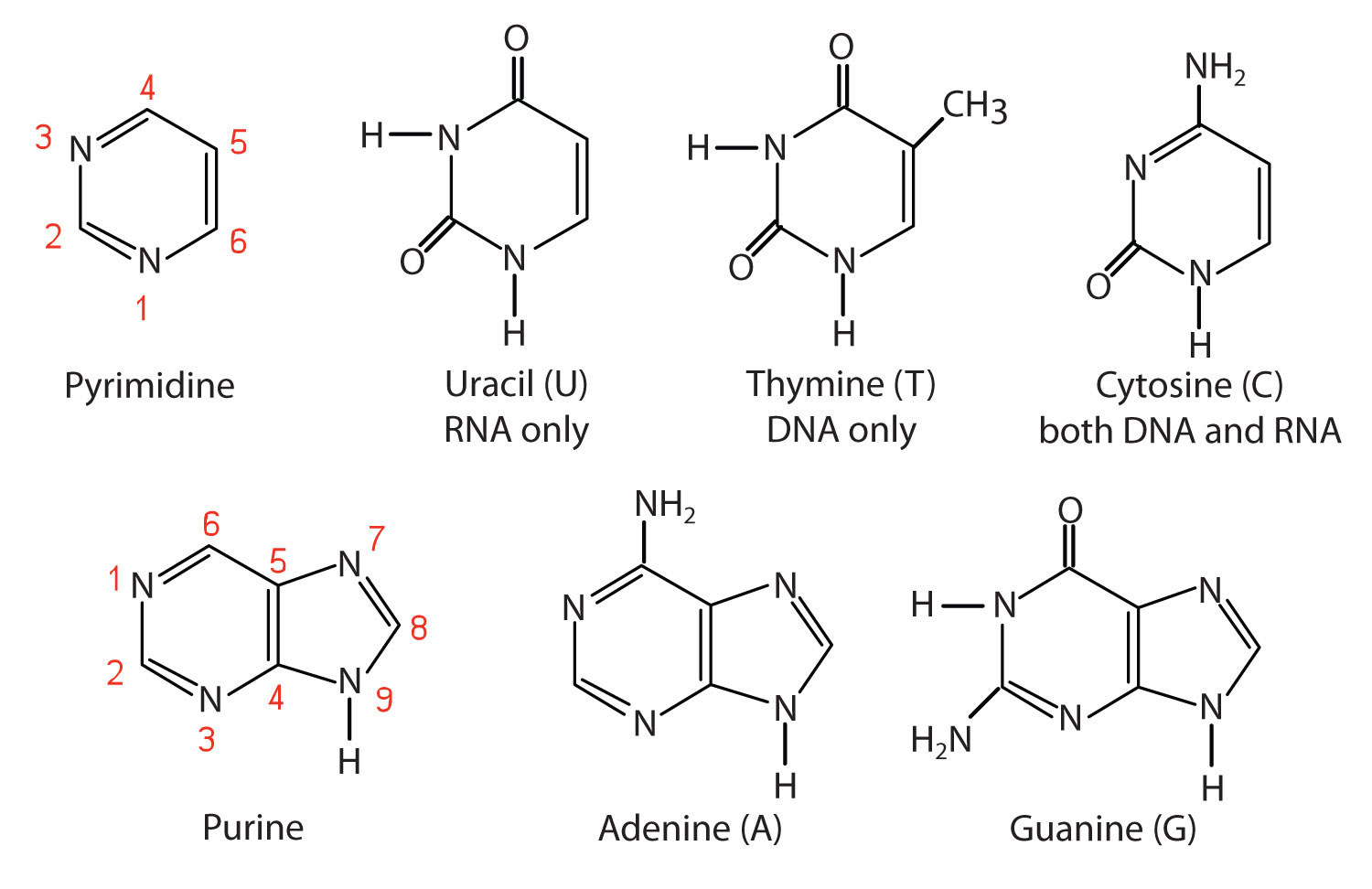
The formation of a bond between C1′ of the pentose sugar and N1 of the pyrimidine base or N9 of the purine base joins the pentose sugar to the nitrogenous base. In the formation of this bond, a molecule of water is removed. Table 19.1 "Composition of Nucleotides in DNA and RNA" summarizes the similarities and differences in the composition of nucleotides in DNA and RNA.
Note
The numbering convention is that primed numbers designate the atoms of the pentose ring, and unprimed numbers designate the atoms of the purine or pyrimidine ring.
Table 19.1 Composition of Nucleotides in DNA and RNA
| Composition | DNA | RNA |
|---|---|---|
| purine bases | adenine and guanine | adenine and guanine |
| pyrimidine bases | cytosine and thymine | cytosine and uracil |
| pentose sugar | 2-deoxyribose | ribose |
| inorganic acid | phosphoric acid (H3PO4) | H3PO4 |
The names and structures of the major ribonucleotides and one of the deoxyribonucleotides are given in Figure 19.3 "The Pyrimidine and Purine Nucleotides".
Figure 19.3 The Pyrimidine and Purine Nucleotides
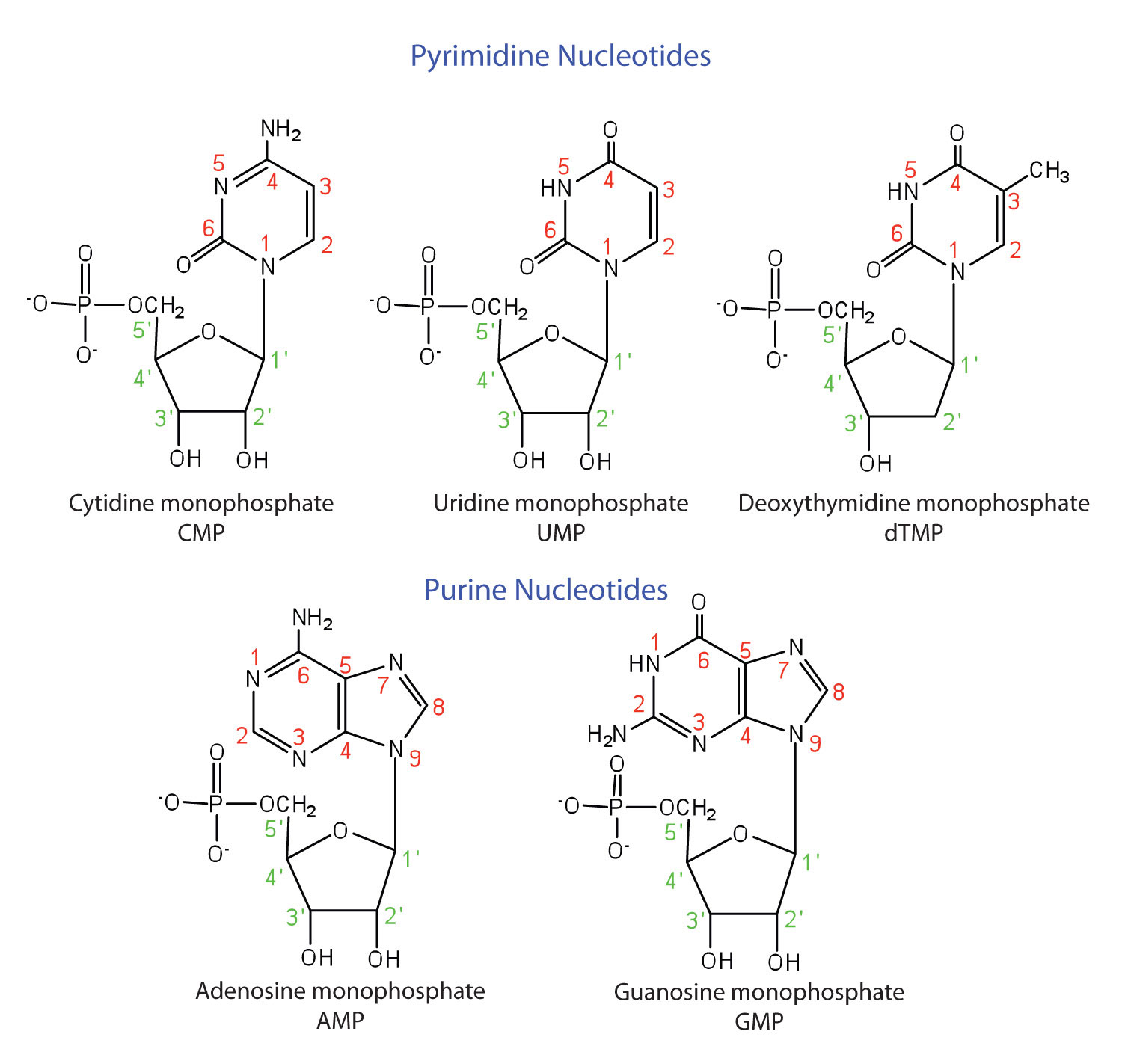
Apart from being the monomer units of DNA and RNA, the nucleotides and some of their derivatives have other functions as well. Adenosine diphosphate (ADP) and adenosine triphosphate (ATP), shown in Figure 19.4 "Structures of Two Important Adenine-Containing Nucleotides", have a role in cell metabolism that we will discuss in Chapter 20 "Energy Metabolism". Moreover, a number of coenzymes, including flavin adenine dinucleotide (FAD), nicotinamide adenine dinucleotide (NAD+), and coenzyme A, contain adenine nucleotides as structural components. (For more information on coenzymes, see Chapter 18 "Amino Acids, Proteins, and Enzymes", Section 18.9 "Enzyme Cofactors and Vitamins".)
Figure 19.4 Structures of Two Important Adenine-Containing Nucleotides
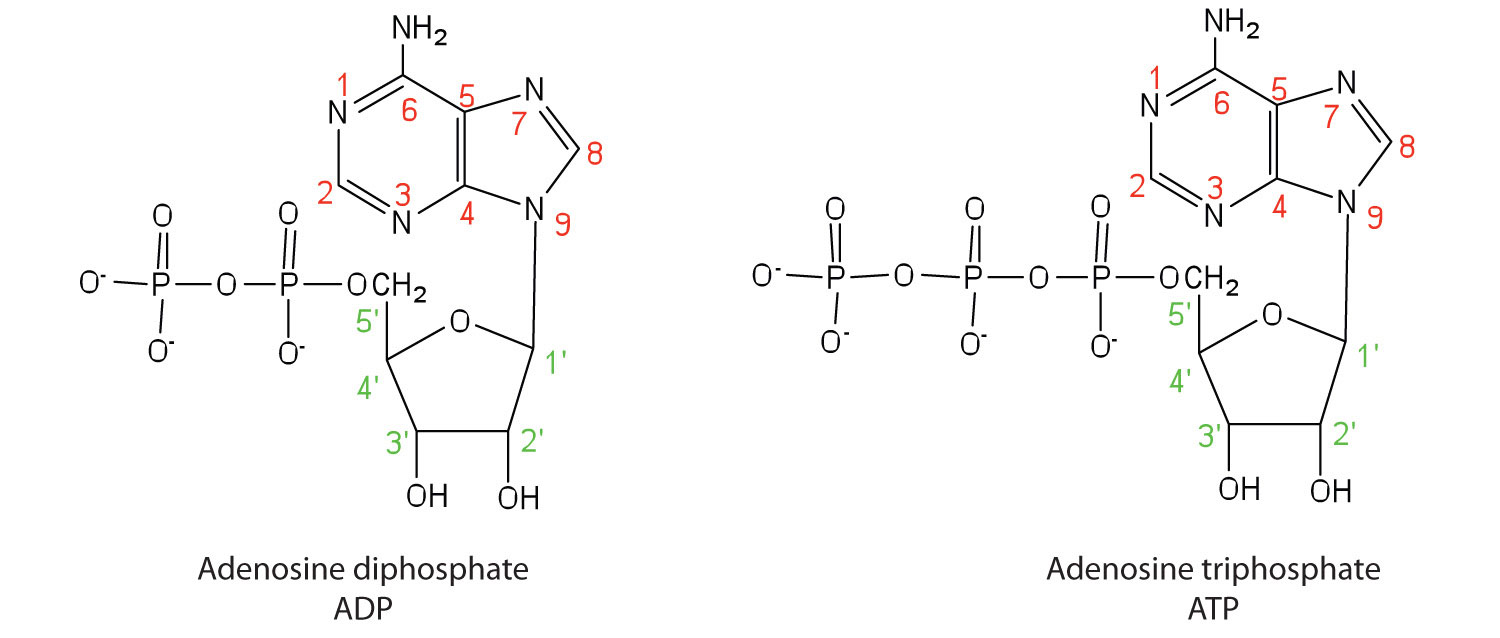
Concept Review Exercises
-
Identify the three molecules needed to form the nucleotides in each nucleic acid.
- DNA
- RNA
-
Classify each compound as a pentose sugar, a purine, or a pyrimidine.
- adenine
- guanine
- deoxyribose
- thymine
- ribose
- cytosine
Answers
-
- nitrogenous base (adenine, guanine, cytosine, and thymine), 2-deoxyribose, and H3PO4
- nitrogenous base (adenine, guanine, cytosine, and uracil), ribose, and H3PO4
-
- purine
- purine
- pentose sugar
- pyrimidine
- pentose sugar
- pyrimidine
Key Takeaways
- Nucleotides are composed of phosphoric acid, a pentose sugar (ribose or deoxyribose), and a nitrogen-containing base (adenine, cytosine, guanine, thymine, or uracil).
- Ribonucleotides contain ribose, while deoxyribonucleotides contain deoxyribose.
Exercises
-
What is the sugar unit in each nucleic acid?
- RNA
- DNA
-
Identify the major nitrogenous bases in each nucleic acid.
- DNA
- RNA
-
For each structure, circle the sugar unit and identify the nucleotide as a ribonucleotide or a deoxyribonucleotide.
-
-
For each structure, circle the sugar unit and identify the nucleotide as a ribonucleotide or a deoxyribonucleotide.
-
-
For each structure, circle the nitrogenous base and identify it as a purine or pyrimidine.
-
-
For each structure, circle the nitrogenous base and identify it as a purine or pyrimidine.
-
Answers
-
- ribose
- deoxyribose
-
-
-
-
-
-
-






